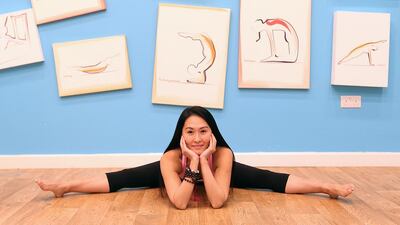When yoga teacher Jo Phee asks her students to lie down for the Bananasana, a stretch for the oblique stomach muscles, they don’t just hold the pose for a few breaths.
The aim is to hold it for about five minutes. It is all part of yin yoga – a restorative modern form of the exercise that has only grown in popularity globally in the past few years.
Phee was one of the earliest proponents of this relatively new slow-paced yoga practice, which was developed by American yoga practitioners Paul Grilley and Sarah Powers.
The teachings upon which it is based, however, stem from the ancient past. They are rooted in the Vedas, early spiritual books from India that describe the practice as sthira (steady) and sukham (content).
Yin advocates mindfulness and meditation, with simple poses held for longer periods than traditional yoga. It also combines postures held by Chinese Taoists to cultivate their ch’i – life-force energy flow.
Phee, who travels the world training instructors on behalf of the founders, was in Dubai recently to guide yoga teachers at the Piloga Studio in Dubai.
“It is probably only in the past five years that yin yoga has gained popularity around the world,” says Phee. “A lot of people feel that they need to balance the busy lifestyle, which is very yang, with the yin half, which is slowing down with meditation and yoga.”
Phee had her own taste of that busy lifestyle. The 40-year-old teacher gave up her corporate job 17 years ago to learn yoga as a way to address her rising stress levels. While she credits other forms of yoga for improving her physical shape, it was yin yoga that allowed her to train her mind.
------------------------------
Classes
Bodytree Studio
Mubarak bin Mohammed Street, Abu Dhabi
02 443 4448, bodytreestudio.com
The Yoga Studio
Royal Stables Abu Dhabi
02 447 7735, info@theyogastudio.ae
Piloga Studio
Dubai Business Bay
04 456 4499, pilogastudio.com
Life’n One
Jumeirah Beach Road Dubai
04 343 6676, lifenone.com
Zen Yoga
Dubai Media City
04 367 0435, yoga.ae
------------------------------
She says she understands why yin yoga was slow to break through to the mainstream.
“People usually love the more athletic aspect of the yoga practice, which is moving the body, sweating and getting flexible,” she says. “Yin is the opposite – it is slow, restorative and quiet. So for a lot of people it doesn’t appeal.”
Yin yoga also focuses on what practitioners call the yin tissue, also known as fascia. This form of yoga complements and assists in recovering from the use of yang tissue, or the muscles, used during daily activity and exercise.
Fascia is the interconnected fibrous connective tissue found throughout the body. It is the cover that surrounds the organs and muscles to protect them from trauma and to assist the musculoskeletal system.
Any distortion in the fascia affects the blood flow to muscles, weakens nerve impulses and reduces flexibility.
The stretches in yin yoga focus on the flexibility of the connective tissue, with moves that moderately stress the joints to strengthen and lengthen them.
Phee, who has been teaching for 12 years, says this makes it a challenging discipline because of the duration for which each pose needs to be held.
“We are conditioned to be averse to pain,” she says. “So in this style, all of a sudden you have to stay in one simple pose for several minutes. The pain and discomfort from the stretching amplifies and you have to endure it. This is where the mind-training comes in. We teach students how to utilise will power, tolerance and patience to bear with that discomfort. It’s a lesson for life.”
aahmed@thenational.ae

